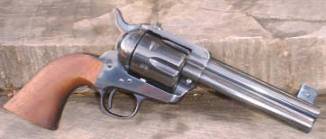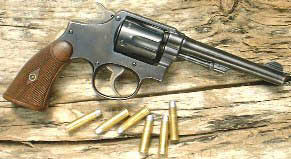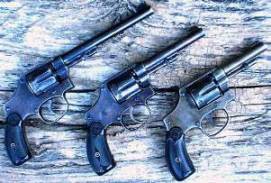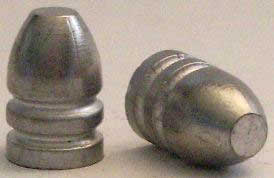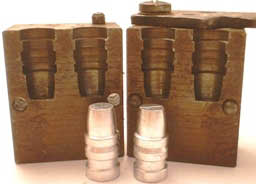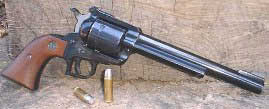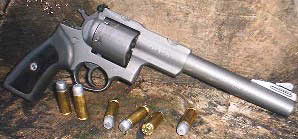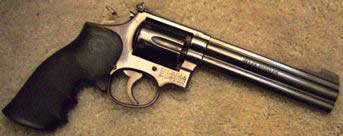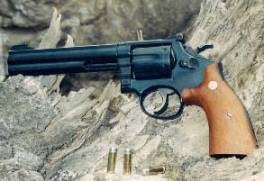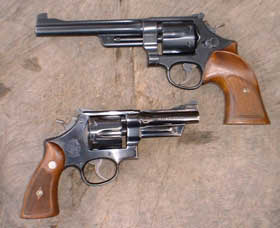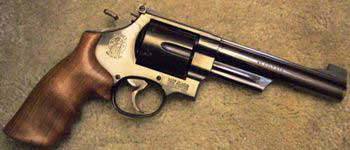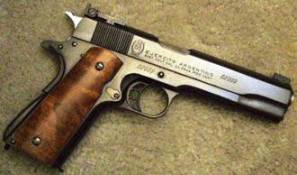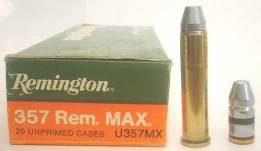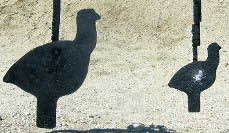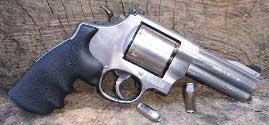|
Chapter 16 - Page One |
|||||||||||||||||||||||||||||||||||||||||||||||||||
|
A Few of Our Favorites... |
|||||||||||||||||||||||||||||||||||||||||||||||||||
|
Now that we've seen a little bit of the history of cast bullets, understand something about the metallurgy of bullet metals, the hows and whys of fluxing, what lube does, what leading is and how to avoid it, where some of the cast bullet designs come from, and how to best exploit cast bullets in hunting loads, we decided to wrap things up with a laid back discussion of a few of our favorite cast bullets and loads. Since handguns get used for a lot of different things, we decided to break this down in terms of application -- plinking, competition, and hunting. So, let’s talk guns, bullets and loads -- the fun stuff! Plinking Bullets and Loads
Plinking is a wonderful pastime, and one that is amenable to just about anything that goes "Bang!". That being said, I have probably burnt as many rounds of .38 Special ammo plinking as I have all other centerfire handgun cartridges combined. In many ways, the .38 Special is the perfect plinking round -- cheap to reload, accurate, sufficient power to make tin cans and pine cones dance merrily, low recoil and muzzle blast (so large volume shooting doesn't have a tendency to cause bad habits), and highly amenable to being loaded with cast bullets. In the .38 Special, I have assembled plinking ammo with dozens and dozens of different cast bullets, from a wide variety of mould makers and historical periods, and the vast majority of them have served their intended purpose admirably. For the .38 Special, I have many favorites from Cramer, H&G, RCBS, Lee, etc., but if I were forced to choose my all-time favorite plinking bullet for the .38 Special, it would have to be the old 150 grain version of the Lyman/Ideal 358477. This bullet is very accurate and is the right weight to extract optimum performance from the .38 Special loaded to standard pressures (about 950 fps when loaded to 16,000 CUP). I generally use 5.4 grains of Unique with this bullet to achieve this velocity, but also occasionally use 4.5 grains of Bullseye. Both loads are very accurate, and make excellent plinking loads. Years ago, I made a believer out of a friend of mine by using this load to put 5 out of 5 shots into a basketball-sized burnt log end at about 150-175 yards, using the 3" S&W Model 60 that I was carrying that day. Not bad for a snubby! Another personal favorite for plinking is the classic .44 Special. There is no finer plinking bullet in .44 caliber than the legendary Lyman/Ideal 429421, Elmer Keith's first SWC design. The 429421 is a very accurate bullet, even out at extended ranges. Perhaps the two most famous .44 Special loads were those championed by Elmer Keith and Skeeter Skelton, and both were built around the 429421. Elmer used stiff charges of 2400 (ultimately settling on 17.0 grains in solid head cases) to achieve 1200+ fps with this bullet from a 7 1/2" sixgun. Skeeter's pet load was 7.5 grains of Unique for a little over 900 fps from his 4" Model 1950 Target. Elmer was a rancher/hunter/trapper who had occasion to use his ever-present sixgun to kill mountain lions, renegade livestock (bulls, broncs, etc.), or targets of opportunity (mule deer or elk) for the Keith family freezer. As a result, he tailored his pet load for the penetration required by these tasks. Skeeter was also a hunter, but his primary use for the .44 Special was in his duties as a law enforcement officer. If he was in a gunfight with some ne'er-do-well, he needed to have adequate punch, pin-point accuracy and moderate enough recoil for quick recovery in case a follow-up shot was needed. So he tailored his .44 Special load to emulate the time-honored .45 Colt -- a 250 grain bullet at 900 fps, except this time it was from a 4" S&W N-frame, instead of a 7 1/2" Colt Single-Action Army. Better sights and tighter tolerances allowed him to place his shots quickly and with precision, and this load provided enough "thump!" to take the fight out of a felon. Each load served its intended purpose very well indeed (and they still do). My general purpose load for the .44 Special also involves Keith's 429421, although it is more akin to Skeeter's load than to Elmer's. I load the 429421 over 10.0 grains of HS-6 for about 950 fps. I originally developed this load using Winchester 540, and used 540 for several years with complete satisfaction, but when that powder was dropped from the market, I switched over to HS-6 and I've stuck with HS-6 ever since. This is an excellent plinking load.
The historical aspects of guns, bullets, and cartridges are a fascinating part of the shooting sports. So I guess it's no surprise that special guns, that were owned by special men, also have a special place in my heart. One such example would a 1930s vintage S&W Military & Police that I own. It is chambered for the .32-20 cartridge, has a 5" barrel, and is in excellent shape. I bought this gun from the late Hal Swiggett several years ago, when he started selling off his collection. Hal has always been one of my favorite gun-writers, and I figured this would be a way for me to preserve a little piece of his legacy in my gun safe, as well as add a special something to my plinking for years to come. This gun is very particular about what it wants to shoot well. It wants .314" bullets (not .312" and not .315"); it wants velocities between 900 fps and 1000 fps (not 800 fps and not 1050 fps), and it wants its bullets loaded over HS-6 (not Unique, 231, Red Dot or HS-7). But with the Cramer #52D 93 grain SWC (this bullet is very similar to the Saeco #325), sized .314" and lubed with homemade moly lube, loaded over 6.5 grains of HS-6 and
sparked with a CCI 550 primer for 1000 fps, it shoots very nicely indeed! Hal once told a story about how he had been asked what his favorite trophy was (a jeweler wanted to make Hal a silver pendant of his favorite trophy, and had envisioned some exotic game animal like a mountain goat, Cape buffalo, or kudu, or somesuch). Hal put a lot of thought into and finally decided that "favorite" had to mean the one that he had derived the most pleasure from, and spent the most time pursuing. His conclusion? The lowly tin can. He told the jeweler this, and apparently his first reaction was disbelief, but eventually he came to recognize that Hal was serious and this was a genuine sentiment. He made Hal a silver pendant of a shot-up tin can, which Hal wore with great pleasure. Every time I shoot this M&P, I think of Hal and his unique style (and unique jewelry!).
Guns and cartridges that might not otherwise get shot very much are right at home in the plinker's gravel pit. Sometimes a quieter, gentler form of plinking is called for, one that harkens back to the simpler, more refined times of days gone by. On these occasions, I break out an old S&W I-frame chambered for .32 S&W Long (Model 1903). These dainty little pre-World War I guns are capable of exquisite accuracy, but they are not strong and must be loaded gently. I assemble special, easily identified loads for these guns, using full wadcutter bullets. I have .32 wadcutter moulds from RCBS, H&G, NEI and Lyman, and for this activity I probably use the H&G bullet the most (but all of them are excellent bullets). The H&G is a 98 grain "button-nose" (i.e. Type II) wadcutter, and for this load I use 2.0 grains of Bullseye. This load runs about 650-700 fps. It is quite accurate, and makes an excellent "stopping load" for those occasions when a renegade tin can decides to charge...
Speaking of the historical aspects of sixgunnery, perhaps the most significant sixgun landmark was the introduction of the .45 Colt cartridge, back in 1873. And there is no finer plinking bullet for the .45 Colt than the traditional RN-FP, like the Lyman/Ideal 454190. I don't like this bullet for formal target shooting (because it doesn't cut clean, full-caliber holes in paper) and I don't like it for hunting (because the meplat is too small, so it doesn’t kill as quickly as a SWC or HP), but it is a very accurate bullet, it carries very well at long range, and it does a dandy job of hammering inanimate impromptu targets of opportunity (tin cans, pine cones, rocks, etc.). While I do have a mould for the old Ideal 454190, it is an old single cavity, and so production can be a little slow with it. I have a 3-cavity Lachmiller mould for an identical bullet, and this mould turns out a pile of bullets in a hurry! I load this bullet over 6.5 grains of Red Dot, for about 800 fps (depending on barrel length). These plinking loads are easily identified because this is the only load I assemble using this bullet. Sometimes plinking is done at close range (i.e. pop cans or pine cones) and sometimes it's done at hundreds of yards, using rocks or stumps on yonder hillside as targets. I have spent many a sunny summer afternoon up in the mountains, flingin' lead at yonder stump, across a draw to a clear-cut on the far slope. The hillside makes an excellent backstop, and on a hot dusty summer day, it is easy to spot your shots from the dust cloud. Ranges can be anything from 100-600 yards, and are commonly 300+. The previously mentioned .44 Special and .45 Colt plinking loads are excellent for these afternoon blast sessions. Another fine load for this is the .357 Magnum loaded with the Lyman/Ideal
358429 173 grain Keith SWC over 14.5 grains of 4227 for about 1250 fps. This 4227 load is not the fastest load out there for this bullet, but in my guns it's the most accurate load I've shot with this bullet. The Keith bullet is very stable and flies well over long distances, making it an excellent choice for long range plinking. One afternoon, I was out at our local shooting range while a friend of mine had RO duty. This was his first shift as RO and he had asked me to come out and shoot so he could have an experienced RO on hand just in case things got busy. I had finished up with the load development work that I had planned for the day, so I was just lazing the afternoon away, plinking at the gongs. At that time, this range had gas cylinders cut in half, stuck up on t-posts for plinking gongs -- cheap, durable and they ring like a church bell when they get hit with a gob of lead. I had a large coffee can full of ammo and was burning it up plinking away at the 300 yard gong using a favorite S&W 686. I use the method that Elmer Keith taught for years about holding up a little extra front sight and "walking the shots in to the target". Once the proper amount of front sight is determined, then the fun begins! Well, I had the sight picture figured out for the 300 yard gong and was just blazing away, having a great time. Offhand I was having no trouble hitting the gong on a regular basis (roughly 40% of the time), and when I missed, it generally was left or right by less than a foot (with the elevation right on). I was having fun, and had a lot of ammo to burn up (I wanted to free up the brass for a loading project I had planned), so I was just loading and shooting, loading and shooting, with my attention focused on the gun and the gong. Suddenly I realized that I was the only one shooting, so I looked around to see if the other shooters were waiting on me, so that they could go downrange and change their targets. That's when I found out that all of the other shooting benches were unoccupied, and the other 5-6 shooters (and the RO) were all standing directly behind me watching me ring the gong! I felt bad because I was holding them up and keeping them from their shooting, but the other shooters said it was no problem, they were enjoying the show! (plinking as a spectator sport…) The RO called a cease-fire and sent people downrange to change their targets, and as he walked past my bench he quietly said, "Remind me to never piss you off!". The Keith bullet is accurate.
Some days plinking is not so much about distance as much as it is about making an impact. Some days the plinker just wants to see his shooting make something happen; take some inanimate object and knock it over, spin it around, or just flat pulverize it. On these days, one of my favorite plinking rounds is the venerable .44 Magnum. Makin' small rocks out of large rocks is one of the .44 Magnum's many talents. Once again, I have used many different cast bullets in these plinking sessions, but looking back over the years, I have undoubtedly shot more 429421s over 23.5 grains of 296 (1350-1400 fps) than anything else. For many years I had a gravel pit about 5 minutes drive from my house, and it was an excellent place to shoot (in the intervening years civilization has encroached and residential neighborhoods now surround this gravel pit, and shooting is not allowed there anymore). There was an excellent backstop and a large population of indigenous targets (i.e. rocks). After the paper-punching was done, we would line up suitably sized rocks (at a safe distance) and reduce them to rubble. The 429421 is an excellent projectile for this work; with a hearty "thwap!" and a puff of dust, another chunk of basalt would go tumbling across the dusty hard-pan. Chunks of cinder blocks were always favorite targets, and this load would just flat pulverize them in a cloud of dust. We had a fun variation on this theme that turned into something of a tradition in one of the hunting camps I've been a part of over the years. One of the guys in camp had a large apple orchard (and his wife made the best apple pies!). Every year, Terry would come to camp with a large box of "rejects" (along with a couple of homemade pies), and inform us that he was not allowed to take any of these home. Most of these apples were as good as you commonly find in the grocery stores, so the rest of us would go through the box and pick out a bunch to take home to our families. Eventually, we would get down to about 15-20 lbs of apples that were bruised, wormy or otherwise blemished. On the last day, we would fix a big breakfast and break camp, giving ourselves lots of time for the drive home. We had to dispose of these bruised apples somehow, so we would set them up in the gravel pit we camped in and have a blast session right before leaving. Apples make excellent plinking targets! As far as cleanup goes, the local deer population was more than happy to help with that chore.
As long as we're on the subject of favorites and rock bustin', a personal favorite for rock crushing is Ruger's big .480 -- nothin' busts basalt like the .480 Ruger! When you get 400 grains of motivated bullet metal flying along, momentum gets transferred and small rocks result from big rocks. Lee makes an excellent 400 grain FP for the .480 Ruger, and for plinking loads I like to size this bullet .476", lube it with homemade moly lube, and load it over 22.0 grains of 4227. This load is very accurate, gives right at 1000 fps, leaves no leading whatsoever in my Super Redhawk, and hits like a ton of bricks. I also like the Lee 6-cavity 400 grain Keith-style SWC (from a Group Buy) for the .480 Ruger for these activities. Competition Bullets and Loads For as long as Mankind has recorded history (and probably much longer), the ability of an individual to place a projectile on a distant target with great precision has been revered. The value that human society places on marksmanship skills dates back through antiquity, and isn't likely to go away anytime soon. The tools of marksmanship, and the concept of "precision" in this context are constantly evolving, but that doesn't change the underlying value we place on the ability of the individual to honorably use these skills to defend innocent life and depose tyrants. Thus, the motivation behind marksmanship competitions. Over the years, these have taken every imaginable form, but in the context of this book (cast bullets in handguns) we will focus on only a few -- bullseye, silhouette, bowling pins and PPC (for those of you wanting to read about cowboy action shooting, let me recommend my good friend John Taffin's book "Action Shooting: Cowboy Style"). Bullseye The basic bullseye course of fire involves .22, centerfire and .45 caliber sidearm's. The full course of fire is a 2700 point match, with 900 points possible for each of the 3 guns, each of which contains slow fire, timed fire and rapid fire stages. There is a great deal of flexibility in the centerfire and .45 stages, but most people shoot their 1911s for both stages. A common misconception is that one must shoot a 1911 for the .45 stage. This is not true -- the rules stipulate that a competitor must shoot a .45 caliber sidearm, with a sight radius of not longer than 10" (hence S&W making revolvers with 8 3/8” barrels), and a trigger weight of not less than 2 1/2 lbs. It not only doesn’t have to be a 1911, it doesn't even have to be a .45 ACP! Just .45 caliber. I have shot a .45 Colt Ruger Blackhawk in state championship bullseye matches and did just fine with it (yes, a single action revolver can be competitive, even in a rapid fire string). For the revolver aficionado, the centerfire stage is most commonly shot with a .38 Special, and the .45 stage with a .45 ACP. The .38 wadcutter is almost synonymous with bullseye competition. The “standard” loads are 2.7 grains of Bullseye or 3.0 grains of Winchester 231 underneath a 148 grain wadcutter. I have always gotten slightly better accuracy using 3.0 grains of Bullseye, and so that’s the load I use. I don’t recall ever chronographing this load, but I would imagine that it’s doing a little over 700 fps. For this load I use both the H&G #50 and the Lyman 358495 more or less interchangeably, depending on whichever I have on hand at the time, and both shoot very accurately (as does the Cramer #16H). I have shot a variety of different .38 revolvers in bullseye competition over the years, but I eventually settled on a 6” K-frame gun, and then ultimately a full-lugged K-frame to make it a little muzzle heavy and “hang” on target a little better. S&W did make a run of Model 14s in the 1990s that were full-lugged, but this gun is actually a 60s vintage gun that was fitted with one of the 90s vintage barrels. The action has been slicked up, and the gun shoots quite nicely. There’s a funny story behind this gun -- I found it at an out-of-town gunshow. I had forgotten my checkbook out in the car and as I walked out to get it, Lyle (who had driven over with our group, and had watched me ogle the gun) bought the revolver. I walked back into the show just in time to see him tear the check out of his checkbook and hand it to the dealer. Thinking that he might have bought it for me to prevent anybody else from buying it, I asked him how much I owed him. His response was simply, “Nah, I’ve decided to take up bullseye shooting” (he‘s a rifle shooter). I knew he was pulling my leg, but he kept up the charade for the rest of the show. When the group of us made it back to the car to drive home, we managed to come up with a ruse to get Lyle out of the car for a couple of minutes and we stashed this revolver in some of my stuff (a 50-cal ammo can with some 10mm brass in it). On the way home, we stopped off for a quick burger. Later, as were we dropping Lyle off, he made a big spectacle about not being able to find his revolver. The rest of us kept a straight face and eventually started to tease him about paying the man and then leaving the gun behind at the gunshow. Each of us drove home chuckling to ourselves about how we had pulled a quick one over on Lyle (a practical jokester whose quick wit usually zinged us). When I got home, I opened the 50-cal ammo can of 10mm brass that I had used to stash the K-38 in, and the gun was gone. There was a message waiting on my answering machine admonishing me not to mess with the Master. I still haven’t figured out how he got that K-38 out of my ammo can and stashed away without any of us seeing him, but he did. He traded it to me a week later, and we both got a hearty laugh out of the whole deal.
Nor do the bullseye rules require the centerfire gun to be a .38 Special, just that it fire a centerfire cartridge, .30 caliber or larger, have a sight radius of less than 10” (again the motivation behind S&W making 8 3/8” barreled revolvers), and have a trigger weight 2 lbs or more. An elegant and very accurate way to fulfill the criteria is with a revolver chambered for the .32 S&W Long, shooting wadcutter loads. Years ago, with this in mind, I commissioned the construction of a tight .32 wadcutter gun, for bullseye
competition and small game hunting. I started off with a centerfire K-frame (a Model 15) and bought a 6” full-lugged barrel that S&W had made for the .32 H&R Mag guns of the early 1990s. I also bought a K-22 cylinder and a set of chambering reamers for a tight .32 S&W Long (.0015” clearances) and .3125” throats (the groove diameter of the S&W barrel is .312”). As I dropped the parts off with my good friend and master pistolsmith Dave Ewer to perform the conversion, he told me that this project would really work better if I was using a Model 19 instead of a Model 15. He pointed out that a Model 15, being built for a narrow-ribbed barrel, has the front end of the top-strap scalloped, and that wouldn’t look right with the wide lug of the .32 Magnum barrel. He also pointed out that the front edge of the frame and yoke are shaped differently for the non-magnum and magnum K-frames, and the bottom of the full-lugged barrel would join the frame just slightly below the flat face milled to receive it. I had been looking for a .32 S&W Long K-frame revolver for many years and was hot-n-lathered up to get going on the project, so I told him to go ahead and do it with the parts I had on hand. As a result of my choices, this revolver has a couple of cosmetic flaws (Dave was right, it would have been better to start off with a Model 19), but the bottom line is that Dave built a work of art with this gun, and it shoots extremely well! When paper-punching is on the agenda, I load this gun with the H&G #66 98 grain wadcutter, sized .312” and lubed with homemade moly lube, over 2.0 grains of Bullseye. I don’t recall ever chronographing this load (Why bother for a bullseye load? It’s going fast enough to punch its way through paper!), but I would guess that it’s going somewhere around 700 fps. This is a very accurate load, and does a good job on small game and small vermin as well. Another line of reasoning holds that larger caliber bullets cut larger holes in the target and therefore, for the same shot placement, have a greater chance of cutting a higher scoring ring and getting the shooter a few extra points over the course of a match. This line of thinking assumes that the shooter is capable of shooting the large caliber sidearm just as accurately as the smaller caliber (as a general statement, most shooters shoot higher scores with the smaller guns). However, that being said, it’s not at all unusual for a match to be decided by a 1 or 2 points (or 1 or 2 X’s), and many times I have seen how one or two shots on the losing target could have made up the difference if they had just been made by a larger caliber bullet, so you have to wonder...
When I’m in this mindset and want to shoot a larger caliber for the centerfire stage (and I’m not trying to rattle somebody’s cage by shooting a “cowboy gun“), I pull out a very special revolver, and one that was literally made for the bullseye game -- a 6 1/2” S&W Model 1950 Target in .44 Special, fitted with thumb-rest target stocks. For bullseye shooting, with the .44 Special, my favorite load is the Lyman/Ideal 429421 loaded over 6.5 grains of Unique for right around 750 fps. This mild load is extremely accurate. While the 1911 is a fine gun, and one of my personal favorites, I am at heart a revolver man. And let’s please keep in mind that the game of bullseye was invented for the revolver, before there were any semi-automatic handguns to compete with! Given the admirable track record that the .38 wadcutter has amassed over the years I felt that it only made sense to try
shooting a .45 Colt N-frame loaded with full wadcutters for the .45 stage. Dave Ewer built one for me by re-chambering and re-barreling a Model 29, to have tight .480” chambers and tight .452” throats. It was fitted with a Patridge front sight and a wide target trigger and target hammer. I have moulds for several .45 caliber wadcutters, but the load that I have used for such activities is NEI 225 grain wadcutter, sized .452” and loaded over modest charge of Winchester 231 for around 700 fps. Of course you can’t talk about bullseye competition with talking about the venerable 1911! Perhaps the all-time favorite cast bullet for bullseye shooting in the 1911 is the H&G #68, a 200 grain SWC with a long nose for smooth feeding. I have shot a number of bullseye matches with the H&G #68, and it is a fine, accurate bullet. But this chapter is about favorites, and if I were forced to pick a favorite it would be the Lyman 452460, also a 200 grain SWC. Some people report having problems with the shorter nose of the 452460 leading to feeding problems, but I’ve never had any such problems in any of my 1911s. My favorite bullseye load is the 452460 over 4.0 grains of Bullseye for about 725 fps. This is a very accurate load, and one that will cycle every 1911 I‘ve tried it in; yes, even the ones with the GI recoil springs.
Years ago, I wanted to build up a 1911 specifically for bullseye competition. Because I was working on a limited budget, I started off with an affordable Model 1927 Argentine, one of the guns that Colt made under contract with the Argentine government. I tightened the frame/slide fit, and fit a Bar-Sto National Match barrel and NM bushing. I replaced the trigger, hammer, sear, mainspring and mainspring housing. Dave Ewer milled the slide down and mounted a Bo-Mar rear sight, along with a Patridge blade of suitable height. Everything came together quite nicely, and this gun is both highly reliable and very accurate. When it was all said and done, putting this gun together was a really fun project, as well as surprisingly affordable (compared to what competition 1911s can run). This gun gets fed a steady diet of the 452460 over 4.0 grains of Bullseye. Silhouette Dynamic targets are always fun, and if you get a target that not only moves around or falls down, but also rings like a church bell, what more can you ask for?! Such is the allure of silhouetting. The standard IHMSA course of fire is two banks of 5 each of chickens, pigs, turkeys and rams at 50, 100, 150 and 200 meters, respectively. Scoring is simple, if it falls down it counts, if it doesn’t fall down, it doesn’t. For an iron-sighted sixgun, it takes a pretty flat trajectory and lots of downrange momentum to knock those rams down at 200 meters. The .357 Magnum was accurate enough and flat-shooting enough, but just didn’t have the gumption to knock over the full-footed rams that were used in the early days of silhouette competition (“full-footed” meaning the entire “foot” of the steel target was on the railroad tie base; later on other conventions were adopted in terms of target placement). This led to the development of new wildcat cartridges (e.g. the .357 Maximum) and the use of larger magnum handguns (like the .41 and .44 Magnums). Being a student of other people’s experimentation, I have followed their lead.
The .357 Maximum was originally developed by Elgin Gates with the specific goal of knocking down stubborn steel rams. Guns were made by Ruger, Dan Wesson and others, and the cartridge was immensely successful at achieving its intended goals. Paranoia surrounding the issue of top-strap cutting ultimately deflated the surge in popularity that the .357 Maximum briefly enjoyed, and the cartridge has been left for dead. ‘Tis a pity, because for hammerin’ steel the .357 Max is a real peach. When distant steel targets are on the agenda, my favorite load is the Saeco #395 200 grain GC truncated cone bullet over 19.5 grains of 4227. I use the CCI 450 Small Rifle Magnum primer for this load because it gives me better uniformity and accuracy (small rifle primers are recommended for the .357 Max due to the pressures the cartridge develops). This load delivers 1570 fps from my 7 1/2” Ruger SBH and excellent accuracy. It is remarkably flat-shooting, and delivers a solid punch at 200 yards. Just like it was designed to do.
Another favorite of mine for ringin’ steel is the .41 Magnum. I have a S&W Model 657 Classic Hunter that absolutely dotes on the Lyman 410459 SWC over 21.0 grains of Winchester 296 (almost 1400 fps). It is very accurate, and the skinny nose of the 410459 makes for a nice, flat-shooting load. Bowling pins Bowling pins are fun to shoot! But they can be stubborn about leaving the table if hit around the edges, or hit with insufficient momentum, so an accurate handgun, with good sights and a certain amount of thump is required to play this game (.38 Special and 9mm are generally considered too light; .40 S&W and .357 Magnum are rounds that start to get a bowling pin's attention). Too much power can mean that recoil recovery time starts to eat up precious tenths of second, so cartridge selection is worth giving some careful consideration to (a .44 Magnum is very effective at sweeping pins off the table, but the heavy recoil tends to slow down follow up shots). A shooter's time is very important in pin-shooting, and since stages are commonly set up to require a reload in the middle, being able to recharge one's handgun quickly is obviously a significant advantage. The .45 ACP is popular for pin-shooting, both in 1911 form and in the S&W N-frame, where the full-moon clips amount to built in speed-loaders. The .45 ACP provides adequate power to sweep the pin off the table, yet has moderate enough recoil to be controllable for fast recoil recovery. A variety of accouterments (ports, muzzle-brakes, full-lugs, etc.) were devised to help with recoil recovery and facilitate faster follow-up shots on "pin guns". Around 1990, a new revolver came on the scene that was destined to pound pins. It was the S&W 610, a stainless steel 10mm revolver. As a result of being built for a rimless semi-auto cartridge, it was loaded with full-moon clips. It had a non-fluted cylinder and a full-lugged barrel to keep weight up, and make the modest recoil of the 10mm cartridge even more controllable. The chambers and throats of the 610 were cut with great precision, and held to tighter than usual tolerances, making them exceptionally accurate revolvers. And it had the fine sights and action of the S&W N-frame. The 610 was born to bowl!
Flat-nosed bullets are thought to be better for pin shooting as they "grab" the slick, rounded surface of the pin for better momentum transfer. Round nosed bullets, even though they facilitate speed-loading, glance off to the side too easily and tend to knock pins over, but just leave them spinning on the table (and remember, if the pin doesn't leave the table, it doesn't count!). As a result, the truncated cone bullet design tends to be popular in this form of competition (smooth ogive for speed-loading, flat meplat for momentum transfer). The gun that I own that is best-suited for bowling pins these days is a 4" S&W 610. It has a wide, smooth trigger for fast double action work, and a black Baughman front ramp to stand out nicely against the white enamel coat of the bowling pin. My favorite load for this kind of shooting is the Lee 175 grain truncated cone, cast of WW alloy and sized .401", loaded over 10.0 grains of HS-7 for right at 1100 fps. The Lee 6-cavity mould makes a pile of bullets in a hurry, and the simple form of the truncated cone design allows the bullets to drop free of the mould with ease. PPC I don't shoot formal PPC competition because I'm not a law enforcement officer, but I have a number of friends who do, and do quite well at it (so I hear about their matches all the time). On occasion I have set up some impromptu courses just to run through the paces and see what it's like. Several years ago I got lucky and was able to pick up a first-class PPC revolver for a very friendly price when a dealer was clearancing his remaining inventory. This gun was made by Spokhandguns, and is based on the S&W 681. It is a switch barrel gun (like a Dan Wesson) with a heavy shroud and a full-length rib. The barrel that it currently wears is a 6" Douglas Air-gauge barrel. The full-length rib was made by Aristocrat, and is topped off with some excellent target sights. Dave Ewer (the honcho behind Spokhandguns) worked this action over with his usual golden touch, and both double and single action are light and smooth. This gun is pure joy to shoot! Mostly I just plink with this gun, and occasionally shoot a few varmints. On these occasions, it generally gets loaded with various .38 Special SWC and HP loads, whatever I'm playing with at the moment. But when I break this gun out in a "PPC frame of mind", this gun gets loaded with .38 Special ammo loaded with the Lee 38-158RF cowboy bullet over 4.2 grains of Bullseye for about 900 fps. I use this bullet for several reasons. Firstly, the rounded ogive of this bullet allows for smooth reloads using speed-loaders (the SWC shoulder gets hung up entering the chambers and slows things down). Secondly, it's a very accurate bullet, so I know if I miss, it's my fault. Thirdly, this is a 6-cavity mould, so I can cast a lot of bullets in short order, making this practice easy to prepare for. And lastly, this is the only load I use this bullet for in .38 Special, making the ammo easy to identify. |
|||||||||||||||||||||||||||||||||||||||||||||||||||
| Continue To Chapter 16, Page Two - Hunting Bullets and Loads | |||||||||||||||||||||||||||||||||||||||||||||||||||
| Table of Contents | Continue to Appendix A - How Old Is Your Mould | ||||||||||||||||||||||||||||||||||||||||||||||||||
| Index of Additional Glen E. Fryxell Shooting Articles |
|
||||||||||||||||||||||||||||||||||||||||||||||||||

